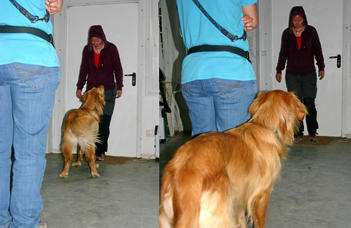How does a dog decide what to do when confronting a suspicious stranger?

Researchers at the Department of Ethology, Eötvös Loránd University and the MTA-ELTE Comparative Ethology Research Group have shown in several studies that the dog’s behaviour in certain social contexts is similar to that of children. In the present study we aimed to reveal whether dogs also rely on social referencing in ambiguous situations just like children. We tested the effect of the owner’s vocal intonation and movement on dog behaviour during an ambiguous encounter with a stranger. As well socialized pets regularly meet unfamiliar persons, to make the situation ambiguous, the stranger behaved in a slightly threatening way; she slowly and silently approached the dog while staring at it, such as a visitor who is hesitant or slightly worried because of the dog’s sight.
In the first experiment we modelled an office situation, in which the owner sits at a table with the dog next to him and the stranger enters the room – says Attila Salamon, the first author of the paper. The owners were told in advance how to react; they were asked to be either friendly toward the stranger or behave suspiciously, as if the stranger was posing a threat. The friendly owners spoke happily to the entering stranger and leaned toward her, while the suspicious owners spoke worryingly and leaned away. According to our expectations, the dogs of suspicious owners looked longer at their owners and remained longer close to her or him, but irrespective of the owner’s behaviour most dogs approached the stranger. "The owners’ behaviour affected their dogs’ reactions, however it is possible that the dogs solely reacted to their owners’ worry and not to the stranger" – Salamon adds.
In a follow up experiment modelling a situation in a shopping mall, the stranger approached from a greater distance. In this case the friendly owner spoke happily and took one step toward the stranger, while the suspicious owner spoke worryingly and took one step backward. The larger distance from the stranger (6 m) in this test allowed the dog more time to notice both the threatening approach of the stranger as well as the owner’s reaction. If the owner behaved suspiciously, the dogs spent more time behind him, but if the owner was friendly with the stranger, most dogs left the proximity of the owner to approach the ’threatening’ stranger. "In sum, it can be concluded that the owner’s vocal intonation and stepping movement evoked social referencing in pet dogs during an encounter with a ‘threatening’ stranger, which can be paralleled with the phenomenon observed in the child-mother relationship" – explains Márta Gácsi, leading researcher of the study.

